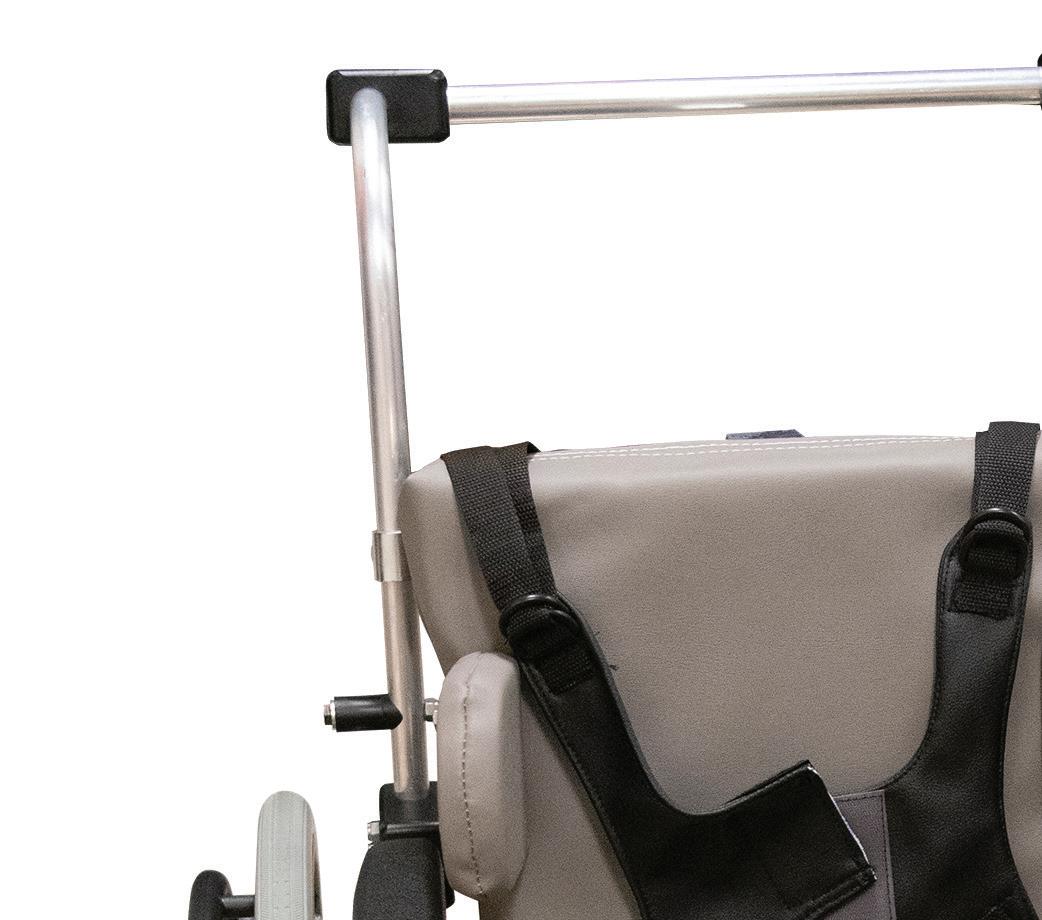
36 minute read
Two senior
THE STORY OF A WHEELCHAIR
Two senior engineering design teams at Dordt University are busy upgrading a pediatric wheelchair that's already having a global impact.
Advertisement
Hope Haven, a life skills ministry program located in Rock Valley, Iowa, has distributed more than 20,000 wheelchairs to disabled children worldwide. By working with eight Dordt engineering majors on two separate changes to the chair, Hope Haven expects to better meet the needs of children who otherwise wouldn’t be able to use the chair. The organization also hopes to make it easier to replace parts from afar.
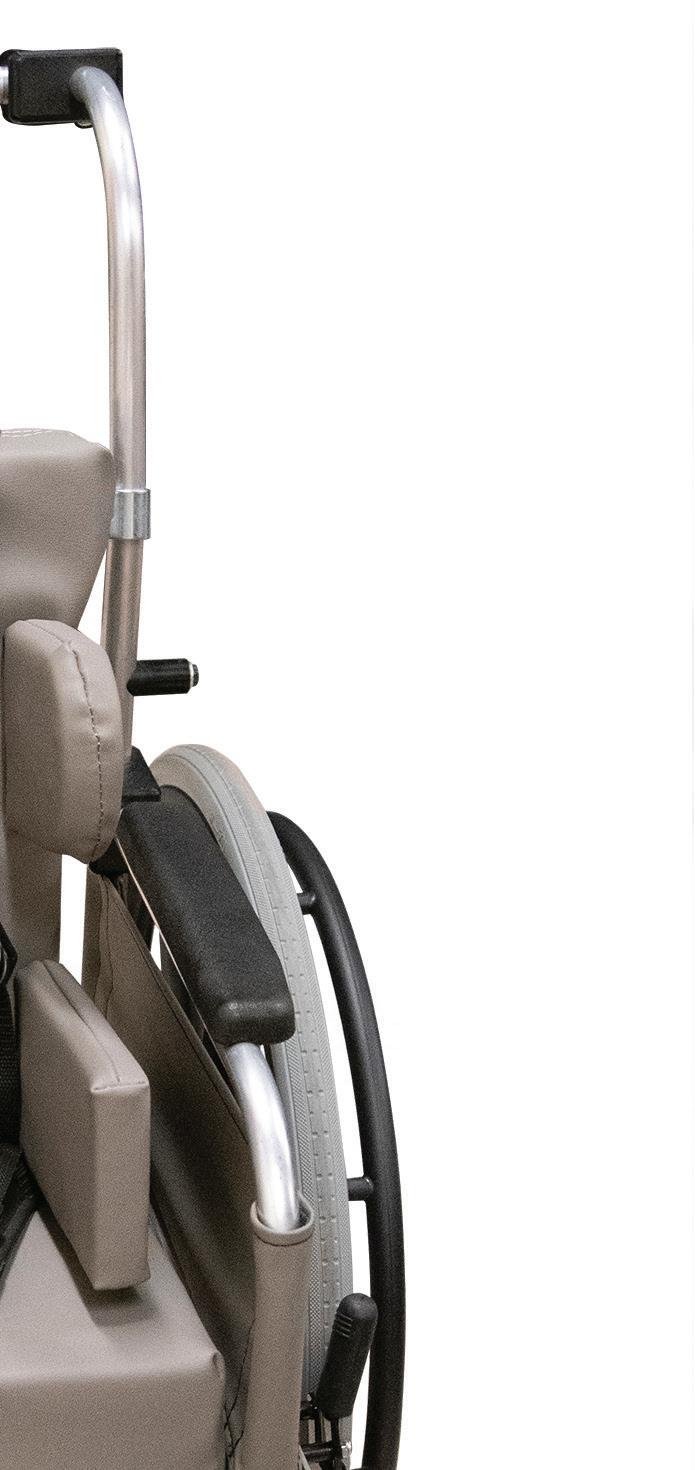
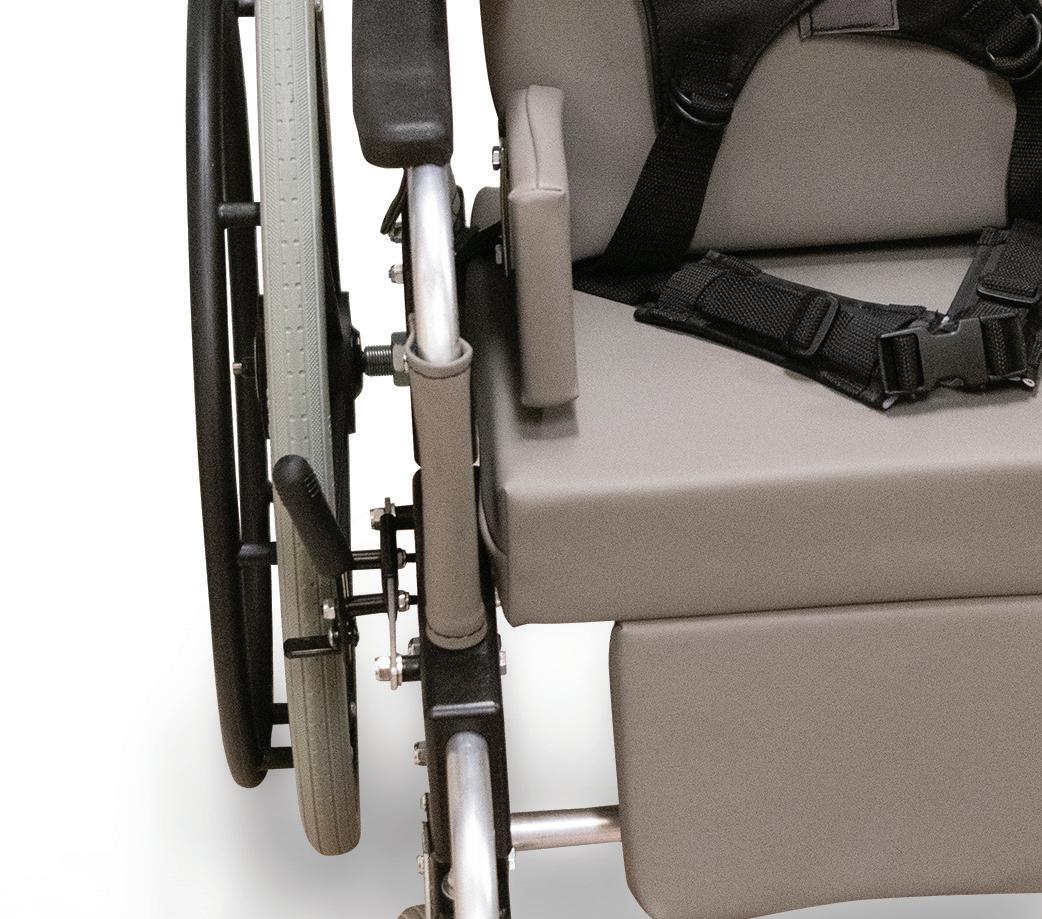
This isn’t the fi rst time the pediatric wheelchair has been part of a Dordt engineering senior design project. The current wheelchair design was born in the engineering labs at Dordt College nearly 20 years ago; it’s now back to be improved by a new group of Dordt engineering students.
DESIGNING LIKE IT’S 1999 The story began in 1999 when Hope Haven approached Dordt’s engineering faculty with a need: Would senior engineering majors be interested in designing a pediatric wheelchair?
Hope Haven already had an army of volunteers who refurbished used wheelchairs to send to people in need, but the chairs were almost all adult-sized. Child-sized wheelchairs were more diffi cult to come by—and more expensive.
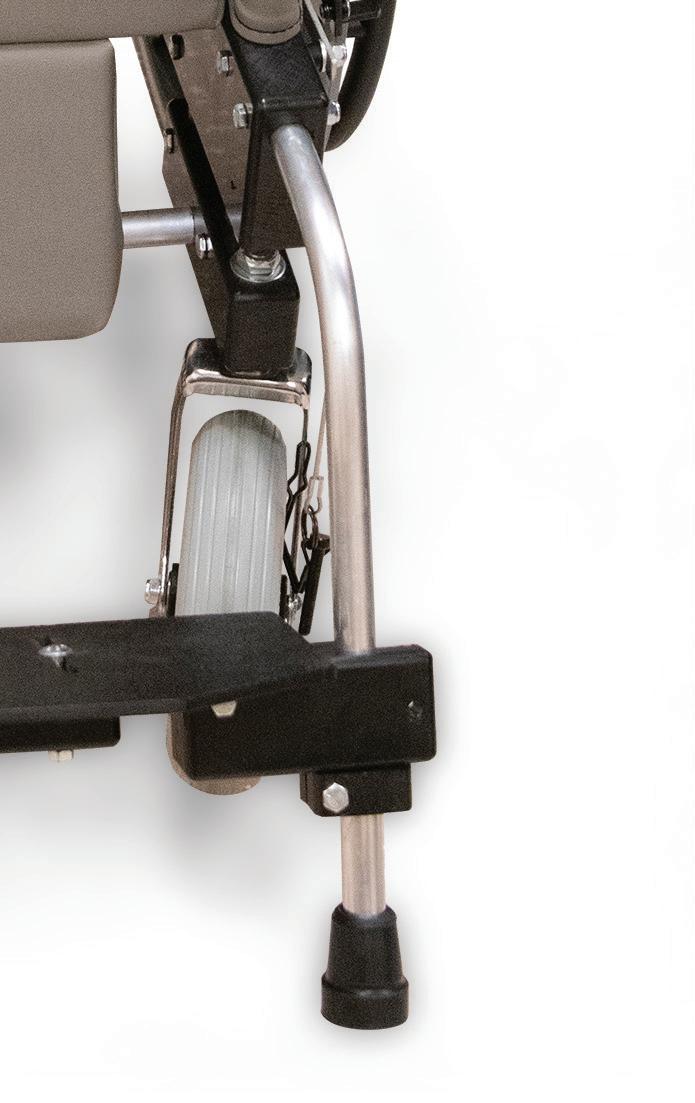

Hope Haven was looking for a pediatric wheelchair that could be assembled and shipped around the world for less than $200 per chair at that time.
“Their idea was that, with some donated spare parts, recycled plastics, and surplus materials from local contractors, they could put a simple
Back in 1999, senior engineering design was worth one credit hour and only one component of a larger engineering lab— not the four-credit hour, two-semester venture that senior design projects are today. Still, Van Gaalen and his fellow engineering faculty members believed their students would have enough time to design a wheelchair.
They connected Hope Haven with Mark Hubers (’99), a senior from Rock Valley. He and his roommates Trevor Mentink (’99), Paul Taatjes (’99), and Micah Vardeman (’99)—all mechanical engineering majors—decided to give the project a shot.
Hope Haven provided some design criteria. The chair needed to be constructed with tubing and blocks. It had to be safe, adaptable, durable, and easy to repair. It also had to be costeffective; in 1999, a typical wheelchair built with purchased materials cost about $335, whereas Hope Haven and the Dordt students wanted to spend closer to $14 using donated material.
Hubers, Mentink, Taatjes, and Vardeman spent most of their time prototyping. Hubers recalls wandering around a warehouse in Rock Valley, trying to find the best use for recycled plastic 2x4s, refurbished wheels, and donated metal tubing. They searched out wheels for their design. They cut the length of the pipe and the plastic 2x4s as joints for the parts that needed to fit together.
“We would put together prototype

As part of their senior design project, Mark Hubers and his team created drawings that highlighted frame and final assembly.
SARAH MOSS ( '10 )
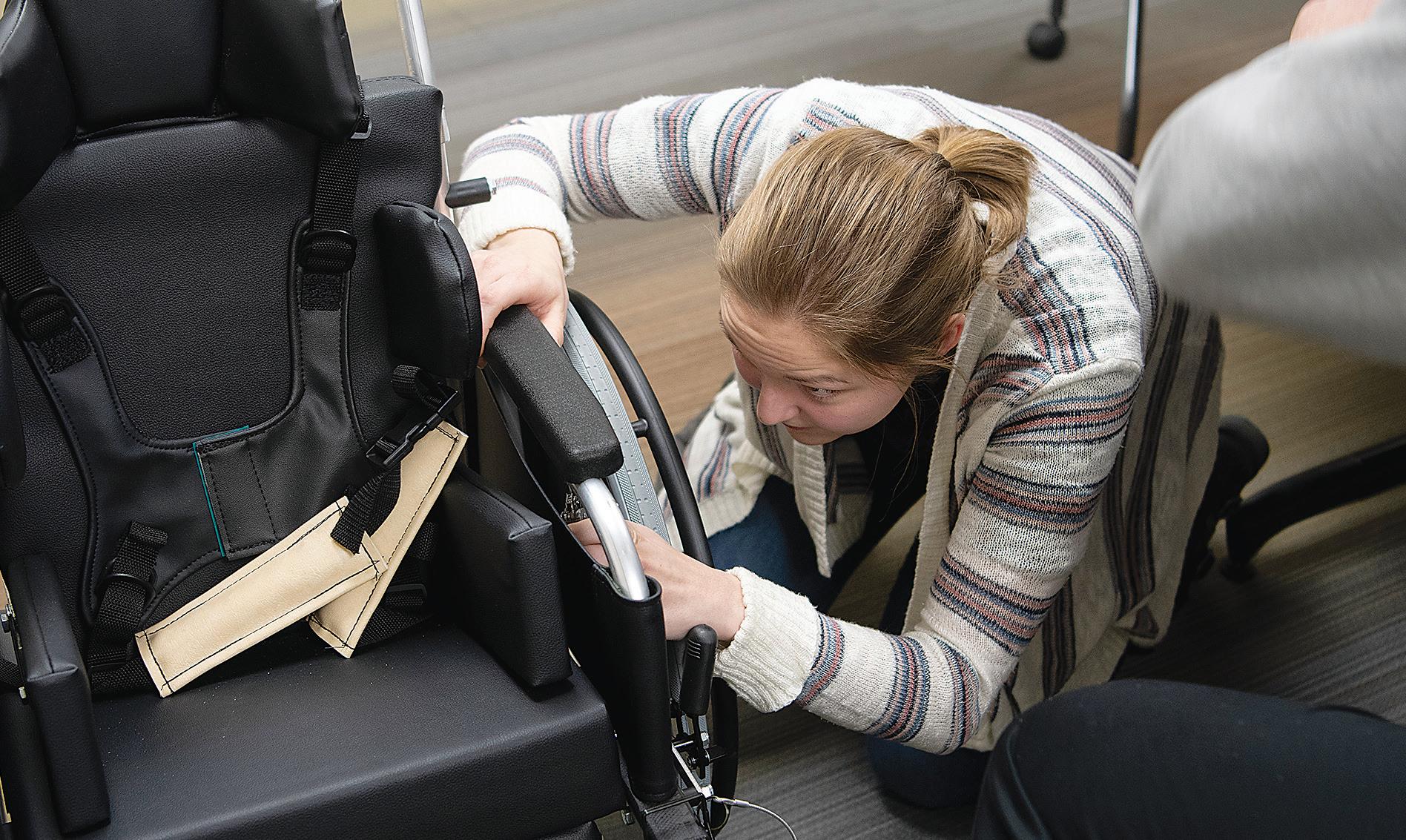
The mechanical tilt team appreciates how their senior design project involves brainstorming, designing, planning, and prototyping.
wheelchairs and wheel them around North Hall, giving them a spin,” says Hubers.
And, when a prototype failed, they’d build another—learning something new with every design they tested.
Eventually, the four students compiled a 21-page report, complete with design criteria, strength analysis, wheelchair fabrication and documentation, and part drawings. They presented their findings to the engineering faculty and to Hope Haven. The rest is history.
At the time, Hubers and his roommates had no idea of the impact their initial wheelchair design would have.
“We were just seniors looking to graduate,” says Hubers. “We knew that the wheelchair design had the potential to affect many lives, but I for one didn’t think it would go to production.”
Since 1999, more than 20,000 wheelchairs have been built and shipped internationally to countries such as Vietnam, Romania, and Guatemala. Word spread to doctors, missionaries, and volunteers around the world that Hope Haven had a simple, cost-effective pediatric wheelchair design. Mark Siemonsma, director of development at Hope Haven, says families have walked 150 miles or more to receive a pediatric wheelchair. “When a child with a disability gets a wheelchair, they and their loved ones gain freedom,” he says. “They don’t need to be confined to a room or depend upon their caretaker for mobility. The
THE TEST OF TIME Dordt’s pediatric wheelchair design has stood the test of time. Modifications have been made over the years, thanks to input from physical therapists and other industry experts, but many of the elements remain the same as they were in 1999. Twenty years later, the wheelchairs are still durable, inexpensive, and easy to repair in the field. They are still making a difference in the lives of children around the world.
Dordt engineering students did that for us; they helped us to achieve our goals. We’re so thankful."
CREATING A MECHANICAL TILT Two years ago, Hope Haven staff again reached out to Dordt’s engineering faculty. The original wheelchair design worked well, but they thought some improvements could be made—a tilt mechanism, a better footrest, and a full computer-aided design (CAD) model of the chair.
Siemonsma talked with Ben Saarloos ('99), Dordt’s lab systems engineer, and Dr. Ethan Brue ('92), an engineering professor, about including these updates as a senior design project. Of the 63 ideas on his list of possible projects, Saarloos recognized that this one would fill an important need, had a clear champion in Hope Haven, and had a well-defined scope.
When it came time for the engineering majors to select their senior projects, eight students picked the pediatric wheelchair as their first choice—more than was needed. Rather than turning students away, Saarloos split the project into two. A group of three students would design the mechanical tilt, and a group of five students would create CAD drawings and design a moveable footrest.

Mykaela Ptacek, Eber White, and Levi Smith comprise the mechanical tilt team, meeting every Thursday afternoon to work on their project. During the fall semester, they spent hours in a conference room, examining a pediatric wheelchair prototype and sketching drawings. During the spring semester, they are spending more time in the 3-D printing lab and the engineering high bay, building prototypes and testing their designs. Ptacek is the team’s project manager, ensuring that they set goals, meet deadlines, and respond quickly to Hope Haven’s questions. The team meets weekly with Saarloos, their project mentor, to ask questions and review their progress. Ptacek says she was drawn to the wheelchair project because she wanted to have a physical product to show at the end of the spring semester—something to follow from design to prototype. She found it an exciting challenge to produce a mechanical tilt on a tight budget, too. “Ultimately, the pediatric wheelchairs are donor-funded, so producing a less expensive chair means it’s more likely that people will want to fund them,” explains Smith. A primary draw of the project for each member of the team was its missional impact. Siemonsma says about 50 percent of the children Hope Haven encounters require the tilt mechanism to use a wheelchair—these are primarily children with severe cases of cerebral palsy and spina bifida. “The original pediatric wheelchair design only helps the less disabled, because the children who have a more severe disability require too specific of a product,” Smith says. “Hope Haven will go into a region and help as many children as they can, but there’s a certain number of children that they have to leave behind. It breaks the volunteers’ hearts.”
The tilt mechanism will help some of those severely disabled children to sit upright and rest their muscles. So, how did the team go about choosing a costeffective, durable design that meets the needs of disabled children? With Saarloos’ help, the students put together a design matrix that examined categories such as safety, cost, and ease of use. Such criteria helped the team determine which ideas to scrap and which to keep. Of the many ways the team could solve the problem, the matrix helps them focus on the design that best fits the need. Mykaela Ptacek serves as project manager for the mechanical tilt group, prioritizing tasks and setting the agenda for the team’s meetings. The original pediatric wheelchair design only helps the less disabled, because the children who have a more severe disability require too specific of a product. — Levi Smith, student
Over the course of the year, the team came up with four tilt design alternatives, which they ran through their design matrix before choosing the one with the highest score. That design has a center of gravity pivot and includes a singlelocking pin, allowing the user to tilt the wheelchair back and lock it into place.
“Having a single pin creates additional design challenges because a single pin will have to merge two frames of the wheelchair at a single point and be centrally located,” says Ptacek.
One important goal of the team was to make as few changes as possible to the original chair. Fortunately, the design of the chair frame required only minor updates. They did make the new wheel frame wider, however, so the chair could sit within the frame of the wheels to give better safety, balance, and stability.
The most challenging part of the project was building a locking mechanism that would keep the chair in its tilted position. The solution eluded them all fall semester; they spent hours brainstorming solutions, but none seemed to fit. Ptacek and White even

“We finally came up with our locking mechanism on the first day back from break, which was really exciting,” says Ptacek. one 90-degree setting and then let the physical therapist or fitter drill the holes in the bar wherever they want to customize the tilt angle, depending on their needs,” says White. “It was really enlightening for us to be able to hear more specifically what they want.”
In early January, Ptacek, White, and two other students also visited Hope Haven’s facility near Antigua, Guatemala. They toured the factory and saw how the wheelchairs were built. They talked with workers to see how the different parts were used, what the machines are capable of, and what fixes the workers thought would be best. Then, they joined workers on the factory floor assembling wheelchairs. Someone else recommended a springloading pin rather than a locking pin, which they’re looking into. This senior design project gives me pride and motivates me to do good work, because I know that the work we do will impact thousands of people. — Caleb Koomans, student
What they learned helped shape how they moved forward.
“Originally, we thought we would set tilt positions at 15, 30, and 45 degrees, but they recommended that we have
SARAH MOSS ( '10 )
“Some say that engineers engineer for what they think the problem is, but the user might have other needs,” says Ptacek. “To see the facility, interact with the people and their culture, and understand where the final product will be used, really helped put our project into perspective and provided a holistic picture as to what and who we’re designing for.”
The group has since built a second prototype of the pediatric wheelchair in Dordt’s 3-D printing lab. Ptacek says they’ll keep refining their design, doing bearing calculations, and working on their final product until they make their senior design presentation in May. They’ll also have to deconstruct their prototype to make sure that it fits in the shipping box Hope Haven uses.
“I’m a visual, hands-on person, so I’ve enjoyed seeing our product come to life,” says Ptacek.
“We know we’re designing something that will help someone,” adds Smith. “It’s highly likely that our design will be implemented in some capacity, because this is already a successful global program. That’s a gratifying feeling.”
ADDING CAD MODELING AND A MOVEABLE FOOTREST Every pediatric wheelchair starts off in Hope Haven’s wheelchair workshops or manufacturing facilities, where volunteers and workers refurbish or
“These facilities have a base model of the wheelchair, but they don’t have official prints or drawings of the chair itself,” says Jaren Brue, a senior mechanical engineering major and member of the second team.
The parts of the wheelchair aren’t even labeled. This can be problematic, particularly if a piece breaks in the field. It’s difficult for a wheelchair owner to request a replacement part if they don’t know what the part is called.
Brue and his four team members are creating CAD drawings of the wheelchair through SolidWorks software and labeling each part in a way that makes sense to both Hope Haven and their disabled clients.
They are also creating a new footrest for the pediatric wheelchair.
“There are certain situations where a patient needs to stand up while in their wheelchair—perhaps to use the remaining strength they have or to get exercise,” explains Brue. “The current footrest design doesn’t allow for this. Our goal is to redesign the footrest so that it’s easy to move so that the patient can sit or stand when needed.”
Like the group working on the tilt mechanism, Brue, Caleb Kroese, Tanner Hulstein, David Van Woerden, and Caleb Koomans were drawn to the pediatric chair project because they wanted to make a difference in the lives of people around the world.

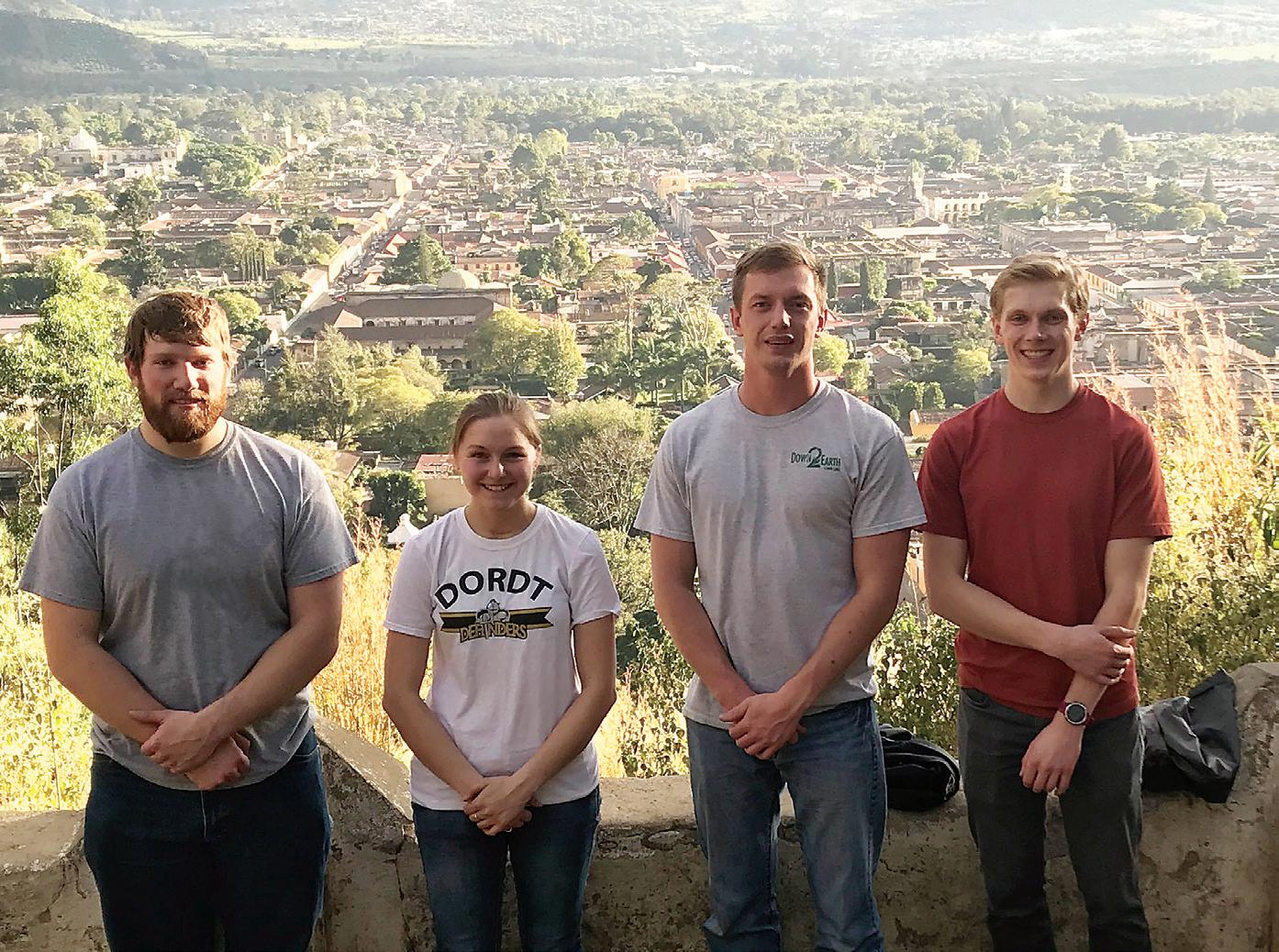
TWO GROUPS, ONE GOAL Despite being in separate groups, the two projects still intersect. Initially, the two teams shared the same pediatric wheelchair prototype, which they’d borrow from the engineering high bay to examine and disassemble on separate occasions. The two groups traveled to the Sioux Falls State Penitentiary to meet with inmates who manufacture some of the wheelchair parts. Two members of each team, Ptacek, White, Kroese, and Hulstein flew to Guatemala in January to visit a manufacturing facility and interact with patients.
“In engineering courses, we talk about what’s a legitimate need and how to design a product holistically,” says Kroese. “With this project, there’s a legitimate need—these people don’t have a wheelchair that’s fulfilling all the things they desire. Hope Haven doesn’t have a parts inventory system or part models.”
“There’s history with this project, too, since Dordt students designed it first,” adds Van Woerden. “Everyone we’ve talked to has mentioned that the wheelchair is well-built, considering how inexpensive it is. So, it’s cool to be able to develop the design further in order to serve a broader range of patients.”
During the fall semester, the team spent much of their time modeling the wheelchair and designing preliminary parts for the footrest. They met with Saarloos at least once a week to get advice and stay on track.
They also learned to find the delicate balance between asking Hope Haven the right amount of questions. “We learned how to ask efficient questions—so, rather than emailing Hope Haven every time we encounter a problem, we try to work through the problem on our own and see if we can come up with a logical way to solve the problem,” says Brue.
Brue, Van Woerden, and Koomans play hockey, and Kroese runs cross country, so finding a time to work together on their senior design project was a challenge, but they made it work. By the time they presented at the preliminary design review in December, they had started developing a simple numbering system using numbers and letters to indicate where parts were located on the wheelchair. They had also created an exploded drawing of the wheelchair—a diagram explaining the relationships of the various parts and part numbers.
“This creates a shared language around how the parts fit together,” explains Kroese.
a footrest: a swinging one-piece footrest that needs minimal modifications and only requires two new parts and one new part design—a footrest block, which will be made of the same plastic Hope Haven already uses. Eventually, they figured out a way to latch the footrest so that it wouldn’t come off in rocky terrain.
In the coming months, the senior engineering majors will complete their designs and finish up their report; in May, they will share their design with fellow students, industry leaders, and Dordt faculty at the annual senior engineering design presentations. There’s still plenty to do, but the team remains motivated by the big impact the wheelchair has had around the world.
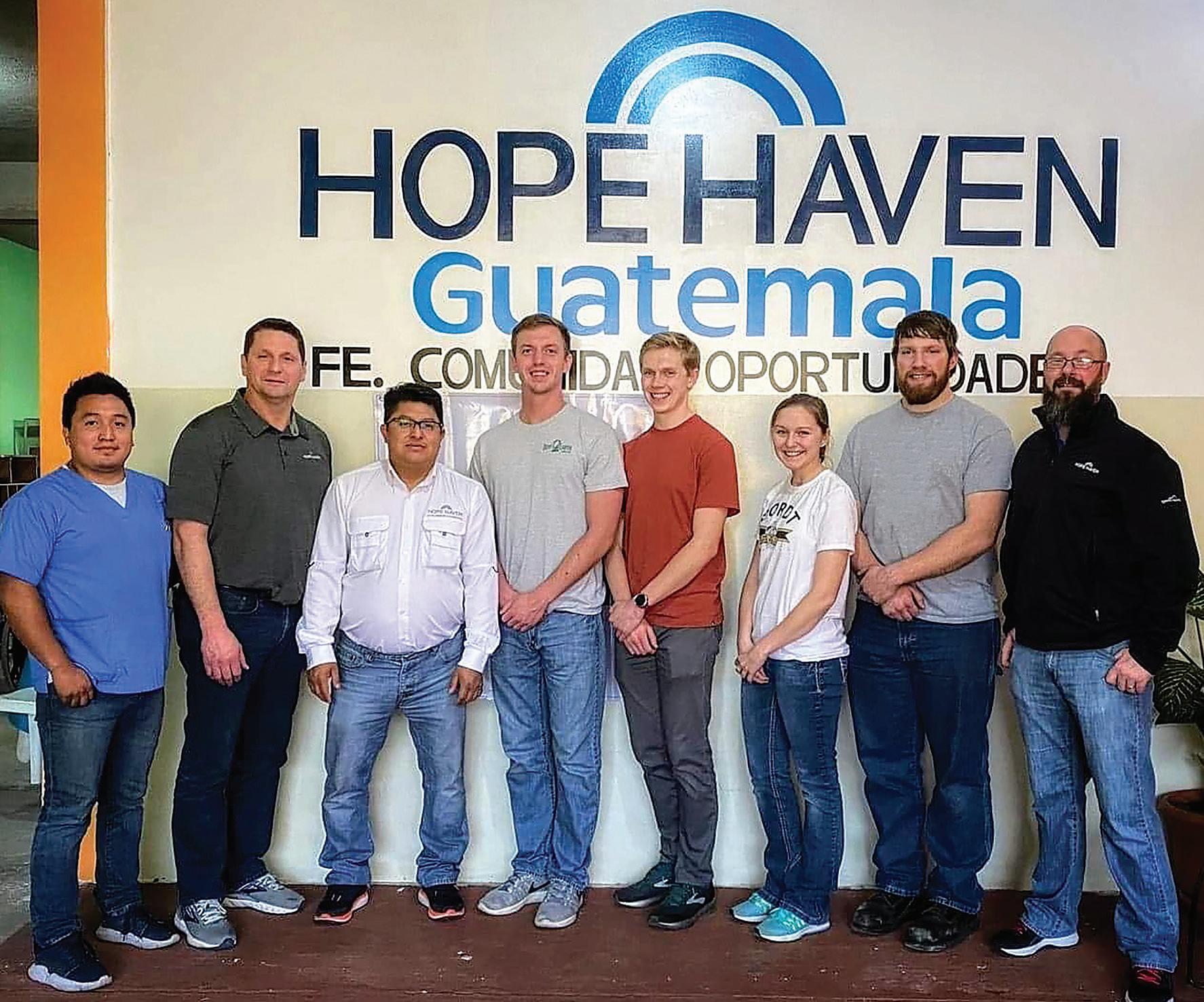
“This senior design project is more than just a learning experience to me,” says Koomans. “We’ve been given a lot of responsibility—we are working on a problem that we know needs to be fixed. It gives me pride and motivates me to do good work, because I know that the work we do will impact thousands of people.”
CONNECTING PEOPLE WITH PEOPLE
"Visiting the facility in Guatemala was a great experience," says Ptacek. "It put the project into perspective and gave us a clear picture of what and who we're designing for."
What stands out to Ethan Brue about the pediatric wheelchair senior design projects is how the students connect to the end user. “One of the biggest challenges of engineering design isn’t necessarily in the technicalities but in imagining the user and trying to put yourself in their shoes,” says Brue. “A good Christian engineer asks, ‘How does the user feel? What uses do they have for this tool?’ When you can answer questions like these, you can better understand what it means to serve.” Visiting manufacturing facilities where parts are created made students more aware of what goes into building the chairs; interacting with patients in Guatemala gave a basic understanding of what needs need to be met through these chairs. These experiences not only helped students gain a better understanding of the project but also helped them empathize with the wheelchair recipients as they considered adjustments to the original design. “With any senior design project, we ask them to think about the social, historical, and ethical issues involved,” says Van Gaalen. “We want them to think about what the clients’ needs are and what stewardship demands there might be. We want them to think from a Christian perspective: ‘How do I come up with the best solution to a customer situation?’” “I think the students like the direct personal connection with the pediatric wheelchair project,” adds Saarloos. “If you’re an engineer at a very large company, there are often so many One of the biggest challenges of engineering design isn’t necessarily in the technicalities but in imagining the user and trying to put yourself in their shoes. — Dr. Ethan Brue, engineering professor degrees of separation between what you’re working on and the people who will be using the final product. With this project, students can directly see who’s using the product they’re working on. That has a big motivating impact.”
The fact that more than 20,000 wheelchairs have been shipped worldwide is ample evidence of how valuable and needed the pediatric wheelchair project is. In some ways, though, Brue believes the students are the ones who benefit the most from this design project.
“Their eyes are opened to needs around the world,” he says. “After they graduate, even if they find themselves serving regionally or locally, they’ll never forget that their world is not the whole world. They can empathize and understand perspectives and needs outside of themselves. I hope they don’t lose that—I hope that same understanding of who they’re working for and why they’re working as engineers trickles down into their work in whatever engineering industry they serve.”







GEN Z FAITH FORMATION
&

Every Thursday night at Praise and Worship, students gather in the Campus Center to lift their voices to the Lord.
“That statistic hit me right between the eyes. I thought back on classmates I went to Christian school with who no longer walk with the Lord. I thought about close friends in my life that don’t, either. This isn’t just a statistic on a page—it’s a reality in my life, and maybe it is in yours, too.”
We stand at a unique moment in the church’s history, argues Baart. Some describe our society as “post-Christian.” The “nones” category—the percentage of Americans claiming no religious identity—is the fastest growing category when it comes to religious affiliation in America, and the percentage of Americans under 30 years of age who identify as “nones” is up to 36 percent.
In October 2019, the Pew Research Center reported that only 47 percent of Christians attend a religious service once a week. The number of people who attend religious services at least once or twice a month is outnumbered by those who attend religious services a few times a year or less. In contrast, 96 percent of Dordt University alumni who responded to a 2019 alumni survey report that they attend church on a weekly basis. This may relate to the fact that Dordt’s stated mission is to “equip, students, alumni, and the broader community to work effectively toward Christ-centered renewal in all aspects of contemporary life.” Part of working toward Christ-centered renewal is recognizing God’s sovereignty over every square inch, in academics and in cocurriculars in college, in worship and in daily living postcollege. Baart and many others at Dordt believe that building serious discipleship formation practices while in college can lay a firm foundation of faithfulness for students once they graduate. In recent years, Dordt has welcomed Gen Z students to campus—young people born between 1995 and 2010. These 18 to 22-year-olds are influencing campus culture during their four years at Dordt and, for a growing number of them, that means taking an active part in shaping the work Campus Ministries does. “Gen Z is a generation of doing,” says Sam Ashmore ('14), discipleship Gen Z wants to produce something of value, not just consume. They want a seat at the table. So, how do we as Campus Ministries create a space for them to have a voice and input? — Sam Ashmore, discipleship coordinator
coordinator. “Gen Z wants to produce something of value, not just consume. They want a seat at the table. So, how do we as Campus Ministries create a space for them to have a voice and input? I think that’s the biggest shift with this generation—to move from students who want to just consume to students who want to produce something.” Sunday evening services. In recent years, attendance has dwindled for both worship events, to the point where Ashmore and the Campus Ministries staff decided to rethink the events’ roles on campus.
“We realized that maybe these events weren’t what students wanted or needed
That realization has led Campus Ministries staff to make room for students to wrestle with their faith and own what they believe. From organizing on-campus worship services to digging into diffi cult topics to leading their own Bible studies, many Dordt students are showing that this unique moment in the church’s history—although a trying one—can bring about spiritual formation, both at Dordt and beyond. The following stories show how Campus Ministries and some Dordt students are responding to such challenges and opportunities. FROM GIFT AND LIFE TO SUNDAY SMALL GROUPS During a retreat last summer, Campus Ministries staff focused their attention on spiritual formation on campus: What’s been working? What hasn’t worked? What does this generation of Dordt students need? “We talked about how this is a generation of producers, and we realized our programming in Campus Ministries is catered toward consumers—that it wasn’t resonating with the generation of students we currently have at Dordt,” says Ashmore. right now. So, we started thinking about ways we can give Gen Z students a way to be heard, because they have opinions that matter and ideas that are valuable.” Ashmore had an idea. What if Campus Ministries replaced GIFT and LIFE with small groups that met on Sunday nights? The groups would be peer-led and off er a way to dig into God’s word and build a culture of vulnerability and authenticity. “Small groups have
always been part of Dordt, but primarily they’ve taken place during the week, and many groups didn’t end up meeting due to obligations like intramurals or class What I've always loved about Monday night worship is that you can feel the Holy Spirit in tangible, raw ways. — Anneka Bakker, student
Two of these programs were GIFT and LIFE. If you attended Dordt in the last 15 years, you probably know that GIFT (Growing in Faith Together) and LIFE (Leading, Instilling, Fellowship, Encouraging), alternated as
Sam Ashmore has served as discipleship coordinator since October 2018.
JAMIN VER VELDE ('99)
projects. By shifting small groups to Sundays, we are hopefully freeing up their time during the week,” he says.
At the beginning of the fall semester, 60 people signed up to serve as small group leaders. Now, nearly 50 groups meet on campus every Sunday, focusing on one of 15-20 studies that Ashmore and others have recommended.
“On Sunday nights, there are 500-600 students in small groups, studying the Bible and growing together. It’s a cool picture of the move of God that can happen when we have a shared goal in pursuing Jesus,” says Ashmore.
Attendance isn’t everything, but Sunday small groups are drawing more students than LIFE and GIFT combined were.
“It’s been really good,” says Tom Oord, a senior theology major. “Small groups provide students with a way to connect with others, and it is a comfortable setting given that it’s led by a student who’s viewed as a peer.”
In the end, the Campus Ministries staff believes that focusing on small groups and ending GIFT and LIFE was the right choice for students’ spiritual formation.
“The Lord has been gracious in sustaining the groups,” says Ashmore. “Overall, this shift has been really positive.”
SMALL GROUP TOPICS Every small group is diff erent. Some read books, like Grace and Truth 2.0 by Preston Sprinkle or The Jesus Questions by Sam Gutierrez ('00). Oord leads a group that focuses on topics related to religion and faith. He and co-leader Damon Groen, a junior worship arts major, meet with 13 other students for three hours every Sunday evening. They’ve talked through questions about LGBTQ issues, genocide in the Bible, and creation. They’ve considered common perceptions on prophesies and prayer; they’ve grappled with whether God changed from the Old Testament to the New Testament. For every topic covered, Oord and Groen prepare carefully and provide sources in advance to help their group fully grasp the topics.
Growing up in Bellflower, California, Anneka Bakker went to a Christian school and attended church every Sunday. But when she started attending Dordt to study graphic design, she decided to be more intentional about her faith.
“When you come to Dordt, you’re presented with so many opportunities to advance your own faith and take intentional steps toward God,” she says.
Part of that involves corporate worship; she tries to attend chapel and Praise and Worship every week.
“But I’d say my favorite worship throughout the week is Monday night worship,” she says.
On Monday nights, students gather in the choir room at the back of the B.J. Haan Auditorium. The lights are turned down low, and a few chairs line the front of the room.
“Students are encouraged to go to the front if they have a message or a word on their heart, or if they want prayer,” says Bakker.
At Monday night worship, Bakker has seen scared freshmen walk to the front of the room and speak words of wisdom. She’s laid her hands on friends who are struggling. She’s sat in a quiet corner and prayed silently.
“What I’ve always loved about Monday night worship is that you can feel the Holy Spirit in tangible, raw ways,” she says.
Tianna Veldhuisen, a senior nursing major from Emo, Ontario, agrees.
“It’s incredible when you can worship with others in such a community and you can be so vulnerable with each other,” she says. “We’re all dealing with the stresses of college life, whether it be relationships, trying to fit in, or academics. I think worshipping with others and laying our stresses before God is a beautiful thing.”
Last year, around 50 people would show up every week. This year, it’s been closer to 80-100 students.
“There have been multiple weeks where we’ve had to get rid of chairs to provide more standing room,” says Bakker.
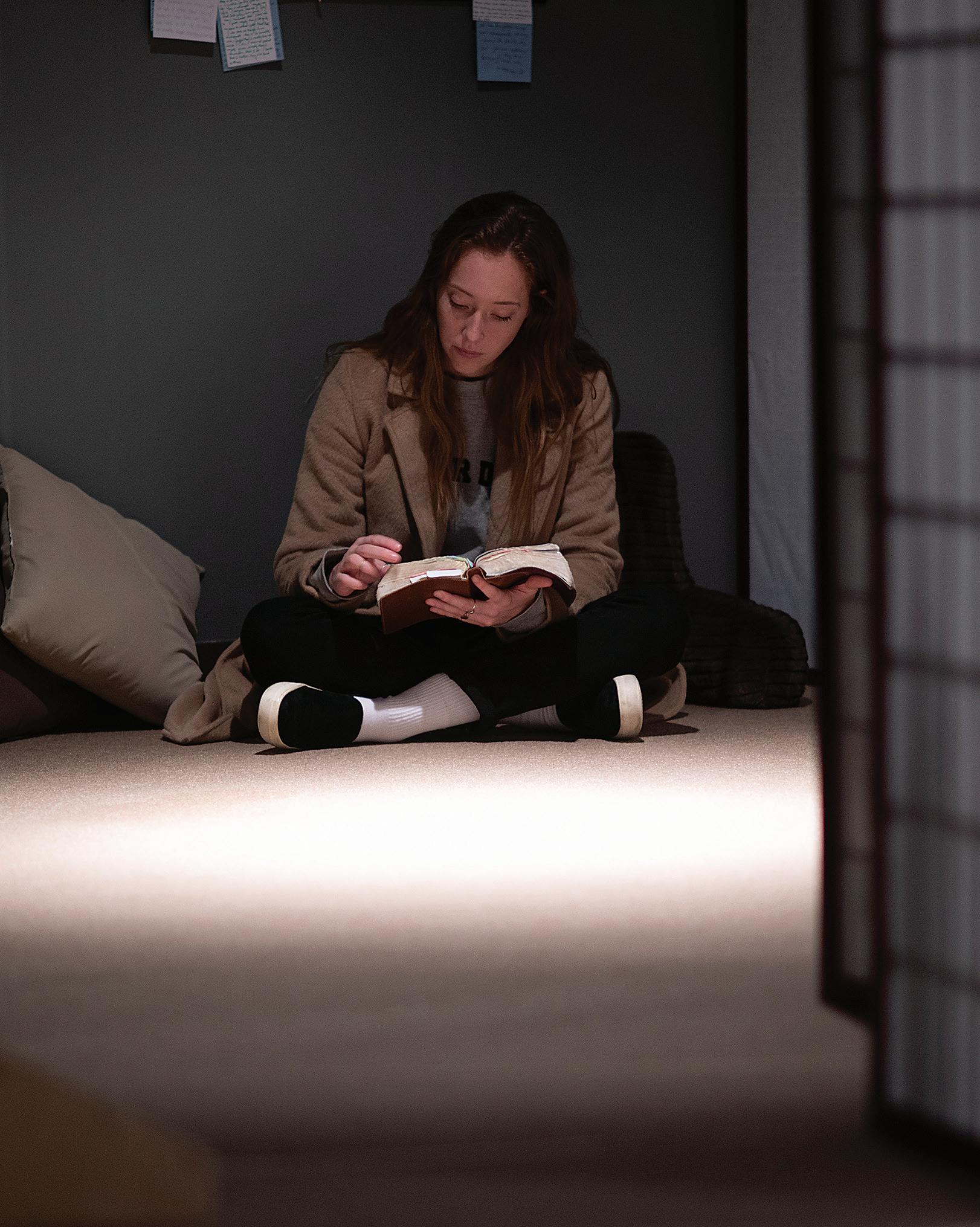
“I think the atmosphere Dordt provides for spiritual growth is unmatched,” says Anneka Bakker. “There are so many opportunities to worship, and you can get to know the Campus Ministries staff, including the dean of chapel, personally.”
Demetrius Rowser, a junior digital media major from Fort Worth, Texas, says Monday night worship had a huge impact on him as a freshman.
“Monday night worship made me more open and vulnerable as a person,” he says. “It’s a bunch of broken people in the same room worshipping together, talking about real life with each other, and just being real. I can’t tell you how important it was to me.”
Monday night worship is entirely student-led. It began a few years ago and is directed by a rotating group of student leaders.
“I’ve never been, and that’s intentional,” says Aaron Baart. “Those of us in Campus Ministries coach their leaders and help them plan, but the rest is up to them. Every generation needs their thing—they need an opportunity to worship in their own way.”
GRACE AND TRUTH CHAPEL SERIES
This fall, when Baart and Ashmore preached a series on sexuality and gender based on Preston Sprinkle’s Grace and Truth 2.0: Five More Conversations Every Thoughtful Christian Should Have about Faith, Sexuality, and Gender, chapel attendance shot up by 30 percent compared to the previous year. If chapel attendance is any indication, students are eager to tackle difficult topics like sexuality.
“The church should be on the front lines when it comes to sex and gender,” says Veldhuisen. “We can’t separate our sexuality from our relationship with Jesus, especially when it’s a vulnerable
The five-part chapel series included discussion about six relational do’s and don’ts; sex, gender, and the Bible; LGBT+ inclusion in the church, and pornography.
JAMIN VER VELDE ('99)
“I think the series resonated with students,” says Ashmore, who spoke about sex, gender, and the Bible during the chapel series. “During and since the series, campus has been buzzing with conversation that people might have been afraid to have before.”

“I absolutely loved how Aaron addressed the issue of pornography,” says Jazmin Mendieta Gauto, a senior education major from Asuncion, Paraguay. “I hate when pastors assume that guys are the only ones with the sexuality problems. Women, too, need to be instructed on topics on sexuality.”
Rowser agrees.
“I never realized how damaging pornography is,” he says. “Aaron’s sermon reminded me that, when you start viewing someone as an object, you’re going down a dangerous path.” “I appreciated Aaron’s message about how singleness can be a gift. At Dordt, there can be pressure to be in a relationship or to get married. So, to talk about singleness and to tell us that it can be good and healthy was really helpful,” says Oord. Bakker believes it’s important to gain understanding and wisdom on important issues. “I think we become better humans by recognizing what other people struggle with, and gender and identity issues are something my generation is especially grappling with. It’s vital that we talk about these issues now because, when we leave Dordt, we probably won’t be in the kind of bubble that we’re in now. So it’s really important that you at least have an understanding of the struggles other people go through.” Baart says he was always taught that a good sermon is the first word on the subject, not the last. “We keep treating sermons as a four-part movement that needs to wrap up with a neat bow, but that’s not what Jesus teaches. With sexuality, everyone wants to look for the one answer, read the one book, or find the magic Bible verse that turns off all their sin. That’s just not going to happen. Addressing unresolved questions shows that discipleship is tension to manage, not problems to solve.” DIVERSIFYING CHAPEL WORSHIP When he was first hired as director of campus ministries and worship arts at Dordt nearly eight years ago, Jon De Groot was told to keep chapel’s worship style consistent. And for many years, students were content with chapel’s dependable style of contemporary worship. Lately, though, that has changed. “It seems like there has been a watershed of interest in worship styles and practices,” says De Groot. “I’ve had students tell me, ‘We need to sing more hymns,’ and others have said, ‘I don’t care if we ever sing another hymn again.’” So, when it comes to chapel music, De Groot has shifted his approach this year. He and the worship team have moved into more experimental approaches to worship style because, as he says, “there are as many personalities and as many ways to connect as there are students in the room.” One senior worship arts major who has pushed the boundaries of chapel worship style is Joseph Bartels. He says it’s vital to remember the expanse of the church both geographically and chronologically, and that affects worship style. Bartels led one service where he used sampled drumbeats and synthesizers to create experimental electronic music. Demetrius Rowser took a leap of faith when he chose to move from Texas to Iowa to attend Dordt. “I needed that space to learn who God is to me and who I am in his eyes,” he says. CHAPEL SERIES To listen to the “Grace and Truth” chapel talks, visit dordt.edu/chapel.
It seems like there has been a watershed of interest in worship styles and practices. — Jon De Groot, director of campus ministries
Influenced by modern musicians like Bon Iver and Post Malone, Bartels says this music style is a language that his generation knows, and it can be used to help them think, feel, and praise in a new way. During another chapel service, Bartels asked chapel-goers to pull out the gray Psalter hymnal from the pews and sing—sans screen—as the Casavant organ played. “I have heard some students find it to be a shame that the organ is not regularly used in worship anymore,” he says. “I personally admire the traditional style of church music; the language and music of some hymns are incredibly rich.” Bartels thinks Gen Z— this generation of Dordt students—is less polarized by worship music than older generations of the church family. He says that, if church music were left completely up to him, he would want churches to use a diverse collection of music genres led by an array of believers with unique stories and situations. “This would help our congregations remember that ‘our way of doing things’ is not the right way. We forget that the Gospel fits into each culture uniquely, and it is a gift that transcends barriers.” formation practices encourage students to wrestle deeply with their faith and allow them to engage with the issues most significant to their generation,” says Baart. Gauto says that Dordt can be a bubble, which makes it even more important to talk about difficult topics like race, sex, gender, and welfare. She grew up in Paraguay surrounded by corruption, violence, and injustice; coming to the United States for school, one topic she thinks should be covered is the construct of whiteness and white privilege. “Not creating those conversations oncampus is pointless, because students will engage in those topics in one way or another,” she says. “I think it’s healthy for Dordt to start these conversations.” One class where the topic of white privilege and racism is discussed is in “Gospel, Church, and Culture,” taught by Theology Professor Dr. Justin Bailey. “I love that course because it made me feel horribly uncomfortable,” says Oord. “We had a whole unit about racism. I’ve always viewed racism as, well, you’re either racist or you’re not. But, just being a white male provides so many advantages. And with racism—there’s no final destination where you can say, ‘OK, I’m not racist anymore,’ because you’ll never find the end of the journey that is undoing all the layers of racism inside you.” Oord also says that building relationships with Campus Ministries staff has helped his faith to grow while he’s been at Dordt. He says that being able to wrestle with difficult topics has been instrumental in his own life. “I think part of the reason a lot of Gen Z is leaving the church is because church Research shows that universities most adept at cultivating enduring faith formation practices encourage students to wrestle deeply with their faith and allow them to engage with the issues most significant to their generation. — Aaron Baart, dean of chapel
“The act of praising with music reminds us of God’s image in us,” adds Bartels. “Songs are not divine; they are gifted to humanity through humanity. Once we are reminded of the inseparable bond between music and humanity, perhaps we will appreciate the praises of others like we ought to.”

TAKING ON TOUGH TOPICS At Dordt, faith formation happens in the classroom, on the athletic fields, in the dorms—not just in chapel, Praise and Worship, Monday night worship, and small groups. But Campus Ministries has a hand in shaping the culture on campus, particularly when it comes to being intentional about lifelong spiritual growth.
has seemingly become irrelevant—not because we find the Gospel to be irrelevant, but because we see how issues in culture—like the refugee crisis, climate change, and the Muslim ban— often aren’t being discussed at church,” he says. “In a similar way, I think it’s important for Dordt to talk about these things, because these are issues that aren’t going to go away.”
Oord would like to see more church sermons have clear, specific action items when it comes to addressing difficult topics, too.
“If we say, ‘This is a biblical truth: Love your neighbor,’ then apply it—for example, ‘This is what structural racism looks like, and here’s what you can do to help your neighbor as we all deal with structural racism,” says Oord.
Oord feels that, looking back at the Grace and Truth chapel series, Baart and Ashmore suggested that kind of practical action. For example, in his chapel talk on pornography, Baart encouraged students to de-digitize their relationships—to stop having intimate conversations on digital platforms. Steps like this give students a way to leave chapel and apply what they learned to their daily lives.
Digital platforms such as social media can be debilitating, which is why social networking is a topic that Veldhuisen hopes the church and Dordt continues to talk about.
“Social networking is a huge part of Gen Z,” she says. “I can’t speak for everybody, but it definitely impacted my life—I’d compare myself to what I saw on the screen. There are challenges when it comes to questions we’re facing about sexuality and gender, and we learn so much about those subjects from social media. There are studies that show that anxiety and depression are on the rise, and that’s partly because of social media.”
In his chapel talk on pornography, Baart also talked about how we all need to learn to rest—often, he said, people end up turning to porn when they are bored, because they don’t know how to be still. This can be true of social media, too— students often turn to social networking when they have downtime.
To help students practice cultivating moments of rest, Baart started Friday Prayers, which happen every second and fourth Friday of the month in the

"All of life is worship, but there is something special about the body gathering for intentional times to adore God and lift up his name together," says Jon De Groot.
PREPARING SMALL GROUP LEADERS Ashmore is intent on equipping leaders well. Every small group leader must sign a covenant stating that they will prepare for and lead a small group, break bread together as a group at least once a semester, attend a campus event, worship together, and be intentional about the small group structure. He instructs small group leaders to focus on five P’s: To create a place for people to belong; to praise God at every small group gathering; to proclaim the good news of Jesus Christ at every gathering; to prophesy, or speak truth, and encourage one another; and to pray for one another.
B.J. Haan Auditorium. During Friday Prayers, Baart leads participants through scripture readings and prayers, all while calming videos play on the screen and soothing music wafts from the speakers.
Whether through prayer times or small groups or Gen Z-friendly worship events, Campus Ministries wants to equip students as they prepare to go out from Dordt.
At the conclusion of his chapel talk on “Why They Leave, and Why It Matters,” Baart talked about how the Christian call is to be “that which is beautiful and refreshing and the best thing that ever happened to everything you’re going to touch and do in this world.”
“I pray for you, Generation Z, students of Dordt. I pray for you during this cultural moment in the American church, that you would be one. Can you hear Jesus’s prayer for us? Can we ask ourselves some hard questions and have some difficult conversations together?”
“You,” continued Baart, “are now the largest generation in this country. What will you do with this, as you form your ecclesiology and raise your voice, as you learn to articulate in new, beautiful ways who Jesus is and what he’s done for you? Will you go and tell what the Lord has done for you in new and convicting ways?”
Then, he asked the students to hold out their hands and to stand for a blessing.
“Father, whatever we create, as cocreators with you, may it look like you,” prayed Baart. “May it be beautiful for the world. And may you bring forth from these hands and from these minds and from these lives, your life. In Jesus’s name, amen.”








